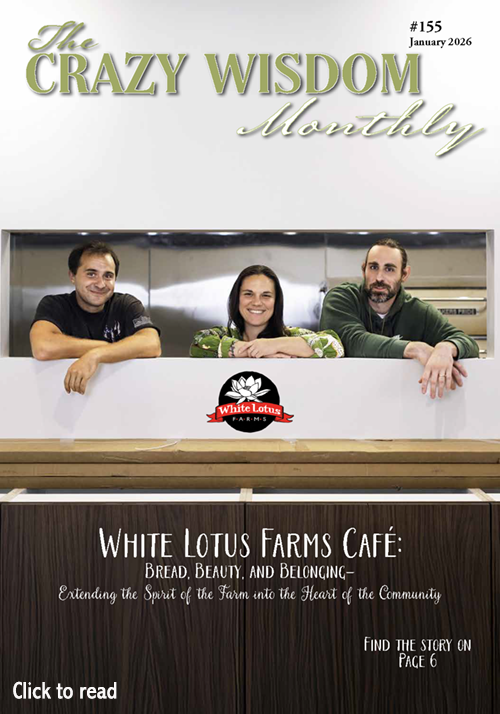By John Orr
There is a wonderful meditation practice that was taught by Gautama Buddha more than 2500 years ago called Vipassana. Vipassana, sometimes referred to as Insight Meditation, helps us to cultivate inner calmness and exceptionally clear seeing into our present moment experience, whatever that may be. I learned this practice as a Theravada Buddhist monk in Thailand in the 1970’s and it continues to be my foundational meditation practice to this day.
When I lived in a Thai monastery, there were two aspects to the development of our meditation practice. One was a formal sitting and walking meditation with a particular emphasis on being mindful of our body and breathing. Mindfulness of the body is a very good anchor and reference point for deeper awareness. Paying attention to our posture and the various sensations that arise in our bodies when we sit, stand, and walk, helps us to feel more embodied and present focused. Especially these days, when many of us spend considerable amounts of time in front of computers and other digital devices. If we can spend just a minute being aware of our bodies sitting in a chair and our feet touching the ground, we are establishing mindfulness of the body and feel more present. If we take the practice a little further and begin to pay attention to the sensations of breathing as air enters and leaves our bodies, we can feel increasing focus and calmness. When we are present with our bodies and breath, we gradually experience less wandering of mind and mental agitation. We begin to see our thoughts and emotions with more clarity and spaciousness. Our whole mental process begins to slow down, and we become less entangled in our thinking and can make more skillful choices for ourselves and those we love.
For example, if we are experiencing fear and negativity around a certain situation that is happening for us at home or work and we are able to be aware of sensations of tension or tightness in the abdomen, shoulders, or jaw, it will help us to recognize we are feeling fearful of something and able to hold ourselves in a kind attention. We may ask ourselves, what am I fearful of right now? Am I fearful of being overwhelmed by the demands of my job and all that has to be done at home? Am I scared that my own needs will not be met? Mindfulness allows us to be present with what we are experiencing and skillfully relate to it with increasing kindness, attention, and spaciousness. That which is aware of fear isn’t fearful. That which is aware of anger isn’t angry. Increasingly we rest in awareness itself and therefore not caught in the energy of the fear and negativity and the myriad stories that are spawned in our minds. Therein lies peace and freedom. Buddha placed great emphasis on freedom from suffering and this is made possible by being present with our experience, and skillfully relating to it, so we don’t get caught in habitual patterns of fear and reactivity.
Read related article: Faster Than a Speeding Bullet :
Freight Trains and the Art of Meditation
A habit pattern that many of us experience is a fear of being unworthy or inadequate—a vague, or even more profound, feeling of shame or that there is “something wrong with me.” Mindfulness, which is the primary tool of Vipassana, helps us to see the feelings of unworthiness as just another aspect of our conditioned minds. Each time the feelings of inadequacy or unworthiness arise we can mentally note ‘feeling unworthy’ or ‘feeling less than.’ When we are present and clear with what we are experiencing in the moment, we are much less likely to get caught up in all the stories of how and why we aren’t up to snuff! These are ancient beliefs about ourself that we carry around like a backpack of heavy stones. It weighs us down and make us feel miserable about ourselves. A formal meditation practice will help us to key in on the most prevalent habitual mental patterns we experience. Perhaps it’s fear that my financial or emotional needs will not be met. Concern I will be alone and lonely, or fear that I’m not safe in this world. Vipassana meditation helps us to see these and other habitual patterns with clarity and spaciousness. As we become aware of these habit energies, and not so sucked into the stories related to them, they begin to fall apart because we aren’t feeding them with unconscious thoughts. This is the power of Vipassana.
The second aspect of Vipassana Meditation is our informal practice ‘off the cushion.’ One of my Thai teachers, Ajahn Chah, placed great emphasis on doing one thing at a time with as much mindfulness as we could muster. Whether it be early morning chanting, collecting our food on alms round, eating our meal, drawing and carrying water from the well, sewing our monks’ robes or any of the other daily activities that comprised our practice. Indeed, there was no distinction between formal sitting meditation and the opportunity to practice mindfulness in everyday activities. This combination of concentrated sitting, standing, and walking meditation, along with moment-to-moment mindfulness throughout the day, is the recipe for enlightened living.
Our western way of life can be busy and fast paced. We are conditioned to move quickly and too often mindlessly. To do otherwise requires an intention to be present with whatever it is we are engaged with in the moment. We can choose specific areas of daily life in which to bring more mindfulness. For example, this week we may intend to pay more attention to preparing our meals, washing the dishes, or driving the car without listening to music or the radio. If we choose one of these activities a week to focus on, gradually we will find ourselves being more present, less mentally scattered, and feeling more integrated into the various aspects of our lives. If we need to clean the house, we might as well do it mindfully and recognize if there is any aversion and resistance to doing it. Bringing attention to aversion and resistance to house cleaning will help us become aware of when there is aversion and resistance regarding other aspects of our lives. Remember, that which is aware of aversion is not averse and that which is aware of resistance isn’t stuck in resistance. Practicing this way makes house cleaning and other activities much more meaningful and full of ease.
Mindfulness and Vipassana are great tools for living and we are fortunate to have them available to us during these uncertain and challenging times. This world we live in is going through a great transition and clarity of seeing, and our ability to keep our hearts open in kindness and compassion, is as important as it has ever been.
John Orr received Theravada Buddhist ordination and training for a period of eight years while living as a monk in the 1970’s in Thailand and India. He has been teaching meditation and leading retreats at various centers around the world since 1980. After retiring from the faculty of Duke University, Orr relocated to his new home outside of Asheville, North Carolina, but still offers meditation classes and retreats through the Deep Spring Center in Ann Arbor, MI (deepspring.org) and you can see his full schedule or offerings at johnorrmeditation.com.




































































































































































































The more present we become, the more we increase our capacity for joy. Learning to be present is challenging, irrespective of age. However, integrating mindfulness practices provides youth the tools to better process their feelings.